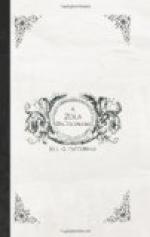HALLEGRAIN (MADAME), wife of the preceding. She survived him for five years, remaining at Clermont, managing as well as she could on her scanty pension, which she eked out by painting fans, in order to bring up her daughter as a lady. During these five years Madame Hallegrain became each day paler and thinner, until she was only a shadow; one morning she could not rise, and she died, looking sadly at Christine, with her eyes full of great tears. L’Oeuvre.
HALLEGRAIN (CHRISTINE), daughter of the preceding, was born at Strasburg. Her father died when she was twelve years old, and her mother, who had a severe struggle to make a living for herself and her child, only survived him five years. Christine was left penniless and unprotected, without a friend, save La Mere des Saints-Anges, the Superior of the Sisters of the Visitation, who kept her in the convent until she got a situation as reader and companion to Madame Vanzade, an old lady who lived in Paris. Chance led to a meeting between Christine and Claude Lantier on the evening of her arrival in the city, and the acquaintanceship ripened into love. Ultimately she ran off with him, and they took up house at Bennecourt, where they lived happily for several years, a son being born to them in 1860. She was devoted to Claude, who was engrossed in his art, and when she saw that he was becoming discontented in the country she urged his return to Paris. There he became obsessed by the idea of a masterpiece, by means of which he was to revolutionize the world of art, and Christine allowed him to sacrifice their child and herself to his hopes of fame. They began to encroach on the principal of their small fortune, and while this lasted were not unhappy, though Claude’s increasing mental disturbance already gave cause for anxiety. Their marriage had taken place some time previously, and this had tended to make her position more comfortable. The exhaustion of their means was followed by great hardships, but Christine continued to sacrifice everything to her husband. The death of their child drew him away from his task for a time, but he again took it up, his mind becoming more and more unhinged. Christine made a last effort to detach him, but the call of his masterpiece was too strong, and one morning she found him hanging in front of the picture, dead. She fell on the floor in a faint, and lay there to all appearance as dead as her husband, both of them crushed by the sovereignty of art. L’Oeuvre.
HAMELIN (CAROLINE), sister of Georges Hamelin, accompanied him to Paris after the death of their father. She took a situation as governess, and soon after married a millionaire brewer in whose house she was employed. After a few years of married life, she was obliged to apply for a separation in order to avoid being killed by her husband, a drunkard who pursued her with a knife in fits of insane jealousy. Living with her brother, in the flat of the Orviedo mansion above that occupied by Saccard, she made the




